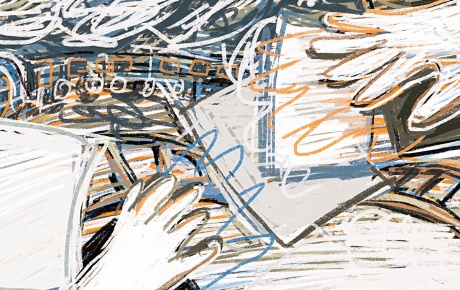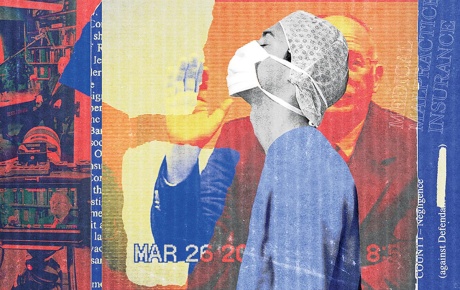
Walking a Fine Line
In late July, experiencing crippling cuts in federal funding, Brown came to an agreement with the federal government. Has the University shrewdly saved itself from bleeding out—or surrendered in a way that invites yet more scrutiny from D.C.?
Gray Babbs has had a tough year. A doctoral student at the School of Public Health, he has been researching health policy and health outcomes for trans people in the U.S. As the Trump administration has purged funding for gender studies from the National Institutes of Health (NIH), he has seen his research support evaporate. “I’ve had five different grants that I work on in some capacity either terminated or pulled from consideration,” says Babbs, who is trans himself. “All of my data access has been rescinded as a direct result of trans people no longer existing according to the federal government.”
When the government threatened to freeze more than $500 million in Brown research funding this spring under vague allegations of antisemitism and potential issues with diversity and inclusion policies, Babbs sympathized with the University. Despite the challenges with funding, he says, his mentors and the administration supported his scholarship and made sure he could continue research to finish his PhD. That’s why it was such a gut punch on July 30 when Brown announced it had signed an agreement with the Trump administration in order to restore funding. As part of the agreement, it would accept the federal definition of gender as only “male” and “female” for the purpose of team sports and would offer women assigned female at birth (AFAB) the option of single-sex bathrooms and dormitory floors. Brown also agreed not to “promote unlawful DEI goals.”
Babbs was shocked to see his university employ—under any circumstance—definitions of gender that undermine his own research. “Brown used trans students and other marginalized students as [bargaining] chips,” he says. Since then, he has heard reassurances from the Brown administration that, while following the law, the University would continue policies of inclusion for LGBTQ+ students and its commitment to diversity in admissions. “I believe they are in good faith trying to make the best of the bad hand they’ve made for themselves,” Babbs says. “But it’s really difficult to hear ‘Hey this isn’t going to be so bad’ when you’re listening from under the bus you’ve been thrown under.”
There was no pain-free alternative, suggests cognitive science professor Steven Sloman, who points out the significant wins: “The University managed to save a lot of jobs, a lot of money, and perhaps even the future of the University.” Brown would be hard-pressed to resist a concerted attack from the Trump administration, he says. “We’re in a time when we have a very vindictive and narrow-minded administration that’s forcing a lot of players around the country to bend to its will,” he adds. “It’s hard to imagine a more powerful entity than the U.S. federal government,” he says, and “Brown lives off federal support.” If the University had refused to negotiate, Sloman says, “the School of Public Health, the Medical School, all of the science departments would have had to fire people. At a minimum, the University would have shrunk significantly and a lot of lives would have been turned upside down.”
Bending Brown to its will is exactly what the federal government should have done years ago, says Christian Diaz de Leon ’21, who says he founded a Brown chapter of Turning Point USA in 2018. “This was a long-overdue correction,” de Leon declares. “Frankly, Brown got off easy.” During his time on College Hill, De Leon says, “I saw exactly how hostile the campus was to ideological diversity.” He feels U.S. higher education “needs massive reform, and there is no place better to start than with our most elite institutions.” He says the Trump administration action was “well within the power and responsibility of the government,” correctly combating “the left’s forever march towards decadence and decay.” Yet he worries that the deal doesn’t go far enough. “Forcing Brown to accept biological reality and merit-based admissions is a nice start,” he says, but “the DEI bureaucracies, activist professors, and overall ideological capture is left untouched. Brown receives its money with barely a slap on the wrist.”
To some, the agreement represents a savvy bit of dealmaking, giving away little of substance while preserving vital funding and academic freedom. For others, it seems a tragic capitulation: the University giving up “its mortal soul,” with no assurances that the feds won’t exact more pain in the future.
Indeed, to some, like the Brown Daily Herald’s editorial board, which did not support Trump’s agenda and crowed that Brown “prevailed,” the agreement represents a savvy bit of dealmaking, giving away little of substance compared to demands placed on other universities like Harvard, Columbia and UCLA, while preserving vital funding and academic freedom. For others, it seems a tragic capitulation to an authoritarian government regime: the University giving up “its mortal soul,” as Philadelphia Inquirer national opinion columnist Will Bunch ’81 put it, with no assurances that the feds won’t exact more pain in the future.
What the agreement accomplished
Everyone interviewed for this article agreed the stakes were extremely high. “When you add up faculty, graduate students, post docs, scientific staff, it is over a thousand people who depend on the NIH for their livelihoods and the progression of their careers,” President Christina Paxson told the BAM in late September. Before the agreement, Brown was losing $3.5 million a week. The University took out $800 million in debt, planning to float grants if they remained frozen, Paxson says, but “the real problem is when they stop issuing new awards or renewing existing awards.” NIH awards, she says, “are like the coin of the realm for scientists.” If those went, “That’s when faculty say, why would I stay at Brown? And graduate students say, why would I come to Brown?” Paxson says. “You’re talking about virtually a demolition of our medical school and school of public health.”
The agreement restored funding and resolved three open federal compliance reviews—around claims of antisemitism and use of race in admissions—with no finding of fault. To achieve that, Brown had to agree to the government’s conditions, which fall into four categories: addressing antisemitism, “unlawful” DEI, “merit-based” admissions, and gender identity issues.
The University’s priority was “remaining true to our academic mission, our core values, and who we are as a community,” Paxson wrote in a letter sharing news of the agreement. University FAQs stress that Brown remains Brown. “Our commitment to openness and cultivating a community of individuals with the full range of backgrounds, perspectives, ideas, and experiences is deep and enduring and remains unchanged.” As an example, Brown has not, the FAQs state, adopted the federal definition of “male” and “female” except in the specific areas outlined by the deal and consistent with NCAA policy.
Paxson says she and her senior administrative team “talked a lot about lines in the sand we wouldn’t cross,” eventually deciding on two: “One is academic freedom, the ability to do research and teach on subjects that we think are important and educate the students we want to educate. The other is autonomy and governance.” Yet the institution had to balance its interests with government priorities. “If you look at what we’re giving as part of the agreement,” she says, “these are all things that the government is either legally entitled to ask any university for, or that we were already doing.”
The Trump administration reflected the agreement differently. “Woke is officially DEAD at Brown,” President Donald Trump boasted on Truth Social. Secretary of Education Linda McMahon praised the agreement as part of “successfully reversing the decades-long woke-capture of our nation’s higher education institutions.”
Students interviewed in mid-September expressed worry and confusion about the agreement. Many declined to talk or insisted on anonymity, citing political concerns, while some said they didn’t know enough to comment. Ananya Pavuluri, a PhD candidate in computational biology, said that funding being restored was “good for me personally,” since she’s part of a multi-institution National Science Foundation (NSF) grant—but not for the University’s future. “I think that we as Brown University, as a progressive campus that claims to be pro-inclusivity and pro-safety of LGBT students, should fight back and say, ‘We are not doing this. We care about our trans students.’”

“Ultimately it comes down to what are we willing to give up to maintain funding?” said Adit Sabnis, a fourth-year PhD student in neuroscience. “I’m a scientist so I’m able to be here because I’m funded by the NIH and if we keep swiping away who’s an acceptable human being, eventually, what, we’re gonna have 10 percent of the population trying to do all the research because the other 90 percent are not correct in their eyes?” Sabnis is organizing director of the Graduate Labor Organization (GLO), which plastered campus bathrooms this fall with signs noting that using the bathroom aligned with one’s gender identity is protected under Rhode Island state law.
A biomedical engineering major expressed skepticism over the government’s concerns of antisemitism. “The administration is using it as a stand-in for trying to remove anti-Israel sentiment, rather than actually being concerned about the protection of Jewish students,” he said.
A student worker for the Brown Center for Students of Color says he felt a change in campus culture after the agreement: “I noticed an immediate hesitation to use language that was previously considered normal and encouraged, such as talking about topics like diversity [and] DEI.”
One senior who asked to remain anonymous says, “I feel like Brown did the best they could with what they had to work with.”
Compared to the agreement Columbia University had signed a week earlier, pledging $221 million in fines to the federal government, Brown made far fewer concessions. Brown agreed to pay $50 million over 10 years not to the federal government but to support workforce development organizations in Rhode Island. “Maybe that’s the kind of money that makes the Trump administration feel like they’ve got a piece of flesh,” says Mushtaq Gunja ’00, senior vice president with the nonprofit American Council on Education (ACE), “but it’s money staying in the state of Rhode Island. That’s very consistent with Brown’s mission.”
At the same time, almost all the withheld money was restored. The only exceptions, according to Brown Vice President of News and Strategic Campus Communications Brian Clark, were programs canceled at the federal level “based on new priorities at the federal agencies,” such as climate change or DEI-focused research. Brown has implemented a Research Resilience and Innovation Fund to make up that difference.
Should Brown have refused to negotiate?
Could the University have done this differently? “They were in a very strong position to say the administration hadn’t followed normal procedures” and fight in court, says Gunja. “But the legal process takes a long time to resolve, and in the meantime if funds are frozen, it impacts our students, our faculty, and our research.” While a loan could have gotten Brown through a year of lost funding, he points out, the next year would have brought hundreds of millions more in lost revenue. “You could have hoped for a better hand, but we didn’t have that hand, and I think this is a deal we can live with. I can very much understand why the president and the board made this decision. It feels bad to give in to any kind of extortion, but the question I have most is whether Brown is giving up something that changes the core of who it is. I think the answer is ‘no.’”
Oliver Hart, a Harvard economics professor who won a Nobel prize for work on contract theory, agrees Brown probably did the right thing in settling. Even though Harvard has won in court, the government has infinite resources to continue the battle and he predicts, as of this writing in early October, that Harvard too will settle. “The government has so much power. We can keep suing and eventually we may win and the government will have to give in, [but then] the Supreme Court might go against us. And even if we keep winning, the government will find some other reason to deprive us. The best strategy is to just suck it up and sign an agreement.”
“You could have hoped for a better hand, but we didn’t have that hand ... The question is whether Brown is giving up something that changes the core of who it is. I think the answer is ‘no.’”
The bigger concern, in his mind, is the vague language in the contracts that Brown and other universities have signed that gives the government wide leeway to come back with future demands. “The role of a contract is that you don’t want the other side to act opportunistically,” he says. “But you can never have a perfect contract, so you’re still relying on the other party to act in good faith.” But the Trump administration, he says, has repeatedly failed to do so, such as deporting people on midnight flights contrary to judges’ orders.
Alex Gourevitch, a Brown associate political science professor who examines history of political thought, including theories of freedom and democracy, believes Brown entering into an agreement at all infringes on academic freedom. It’s “already a concession to the idea that it’s okay for the government to fully coerce and extort universities for its own political priorities,” he says.
His view is echoed by Daniel Souweine ’01, an entrepreneur and former political organizer for Bernie Sanders who, this spring, organized Stand Strong Brown, an alumni group opposed to any deal that gathered 1,500 signatures in a petition and rallied hundreds of people to hold signs as they marched through the Van Wickle Gates in May. “This strengthens the hand of an authoritarian government to further press their ideological case,” he says. “I’ve had lots of interactions with alums through this organization, and one of the things I’ve heard again and again is that at Brown people learned to fight for what they believe in.”
Close to the BAM’s press time in October, the federal administration sent a letter to Brown and eight other universities conveying a set of standards it wants universities to accept in exchange for “substantial and meaningful federal grants.” The “Compact for Academic Excellence in Higher Education” implied that institutions that do not sign would forgo federal grants. Requirements included capping international student numbers, freezing tuition, adopting the federal definition of gender, and eliminating departments that “purposefully punish, belittle, and even spark violence against conservative ideas.”
Multiple news outlets reported the White House viewed Brown and the other institutions as “good actors,” with Brown possibly on the list after signing the July 30 agreement— the type of gateway to potential further government demands that some who were interviewed said they feared.
Paxson reached out to the Brown community for input on October 9. Six days later, on October 15, Brown was the second university to reject the Compact, after MIT, with Paxson writing: “I am concerned that the Compact by its nature [...]would restrict academic freedom and undermine the autonomy of Brown’s governance, critically compromising our ability to fulfill our mission.” She added, “Brown’s existing agreement with the federal government expressly affirms the government’s lack of authority to dictate our curriculum or the content of academic speech—a principle that is not reflected in the Compact.”
“Bravo! (and whew)” was among the first comments about this in the Stand Strong Brown alumni Facebook group.
What “addressing antisemitism” will mean
In signing the July agreement, Brown agreed to take “significant, proactive, effective steps to combat antisemitism and ensure a campus environment free from harassment and discrimination.” Some community members have been concerned that the focus on antisemitism means that other types of harassment and discrimination will take a back seat. Brown says no. The provisions on antisemitism correspond to the government’s compliance reviews investigating antisemitism that were dropped thanks to the agreement, the University says. Brown’s focus is still “around making sure that people can bring forward complaints about harassment and discrimination…around anything,” Paxson says. “Whether it’s race or transphobia or veteran status or other things.”

No one disputes that the last two years have been difficult ones for many Jewish communities. “Brown has been no exception to that,” says Rabbi Josh Bolton, director of Brown-RISD Hillel. “There’s no doubt that Jewish students have faced increased antisemitic rhetoric” and worse, he asserts. At the same time, Bolton says, Brown has been an extraordinarily welcoming place for Jewish students and faculty, thanks to recent initiatives and investments including an expansion of kosher options in the dining halls. “Over the past five to ten years, Brown has emerged as one of the great places to be a Jewish student.”
What the resolution agreement lays out includes supporting research and education on Israel and enhanced security for Brown-RISD Hillel, as well as engaging an outside firm to conduct a survey to evaluate the campus climate for students with Jewish ancestry. To the extent that the agreement benefits the Jewish community, Bolton supports it. At the same time, he sees the agreement as a new chapter in a long history of Jewish communities being exploited. “The left and the right have long engaged in political charades with regard to Jewish safety,” he says. “Part of the violence of that politicization under the current American regime is the way in which Jewish safety, as reflected in this agreement, somehow comes at the expense of LGBT safety. No community’s safety should come at the expense of any other.”
A particular danger of the provisions regarding Jewish safety, says Hart, the contract expert, is the way in which vague language about the Jewish community survey opens Brown up to further weaponization of Jewish issues. According to the agreement, Brown must summarize the findings of the climate survey and present an action plan to the government. If the government rejects the plan, there are no provisions for how that will be addressed. “What happens then, is the deal off?” Hart says. “There’s no board for them to appeal to.”
What about admissions and DEI?
The 2023 U.S Supreme Court case Students for Fair Admission v. Harvard prohibited race-conscious admissions. The agreement enshrines this concept as committing Brown to
“merit-based admissions practices.” The University may not preference applicants based on race or use anything as a proxy for discrimination, such as “personal statements, diversity narratives, or any applicant reference to racial identity.” A separate provision says that Brown may not, in any part of the University, “maintain programs that use unlawful efforts to achieve race-based outcomes, quotas, diversity targets, or similar efforts.”
All of that language is intended to “delegitimize diversity, equity, and inclusion,” says Jonathan Feingold, an associate professor at Boston University School of Law who focuses on race and the law. “This is an attempt to advance a viciously racist narrative that Black people are unqualified to be in any seat of power,” Feingold believes, and “you have language in this document that is conceding the frame.”
Legal scholars have debated the meaning of the SFFA decision, with some pointing to Chief Justice John Roberts’s own language within the decision stating that while race cannot be considered by itself in a decision to admit a student, it can be considered as part of the totality of a person’s experiences. Brown itself embraced this reading, stating in a document it released after the decision that while considering “race for race’s sake” is unlawful, universities may consider “an applicant’s discussion of how race affected the applicant’s life.”
The vagueness of the agreement’s language on use of “proxies” such as personal narratives regarding race could be read as prohibiting such considerations, says Feingold—though expressing “individualized experiences of racism” is “wholly consistent with the Constitution,” he adds. “The reason [the federal administration] wants that concession,” Feingold says, “is because it would not actually be able to prevail in litigation.”
Brown entering into an agreement at all ... is “already a concession to the idea that it’s okay for the government to fully coerce and extort universities for its own political priorities.”
While it’s still unclear if or exactly how Brown will tweak its admissions policy, Provost Francis J. Doyle III says Brown will continue to ask applicants for personal statements. The agreement “doesn’t say we can’t use them,” he says, but rather “it says we can’t use them in an illegal manner.”
Paxson goes further: “The idea that we would admit students to Brown based solely on their test scores, it’s ludicrous. We’re looking for students who are intellectually curious and who are resilient and who are going to thrive in the Open Curriculum, which is a very different approach to education, and you can’t assess that just by looking at two numbers [grades and SAT scores].”
The agreement also provides for the release of anonymized data on admissions, including race, gender, and test scores. The University points out that this is data that it has long been required to provide to the federal government upon request. Yet Feingold fears that the Trump administration will “manipulate that data in order to tell the story that Brown is admitting unqualified Black students.”
In its communications about the agreement, Brown has unequivocally upheld its commitment to diversity, describing it as essential to academic excellence. A new vice president for diversity and inclusion started in February, and in August Paxson announced a “conversation across campus” during the 2025-2026 academic year about “the meaning and significance of diversity and inclusion for our teaching and learning community.”
What’s changing for trans students?
“One of the misunderstandings we’ve received is that we’ve adopted a binary definition of gender,” says Clark. “And that is not the case at all. We are simply adding options,” he says, to comply with the agreement. University FAQs note that Brown never offered gender assignment surgery and that Health Services typically refers students to outside providers for gender-affirming hormonal care. Bathrooms outside of athletics facilities will continue to be open to trans students according to their gender identity, Clark says. How to accommodate any women who request bathrooms restricted to AFAB women is still being worked out, he adds.
Clark says first-year students are already assigned to floors based on sex assigned at birth and can opt out by choice; currently upperclassmen too can request a single-sex floor, and those options will be provided based on demand. “This isn’t generally something on the minds of most students these days,” says Clark. “So there’s been little need for it. We’re trying to make clear this is an option already for people who wish, even if it doesn’t come into practice all that much.”
When it comes to athletics, the University stresses that it is following rules set by the NCAA, which in February prohibited trans women athletes from competing on women’s teams. While varsity locker rooms will reflect NCAA eligibility, Paxson says, “We don’t have reserved locker rooms for club sports. Those students go back to their dorm rooms to shower. We’ve made sure that in all of our athletics facilities we have single-use, lockable changing and showering facilities that can be used by anybody who wants more privacy.” People are free to choose single-use facilities for any reason, including not sharing the space with a trans person, Paxson says. “Our approach has been to make sure there are more of those options available on campus.”
Reassurances aside, the University’s willingness to make any concessions at all on the issue of trans identity has deeply unsettled some members of the community. “I was a closeted kid from Texas and came to Brown and found a really welcoming community,” says alum Jen Corn ’94, whose daughter now attends Brown. “Even if the day-to-day experience of a transgender person doesn’t change, the message sent by this agreement is that your rights and well-being are expendable,” she says. “To see the institution that had been such a transformative and supportive part of my own experience as a young person betray its transgender students like this, it just broke my heart.”
Paxson says that while she realizes not all community members would agree on the Trump administration’s definition of sex—and she might not agree with it herself—the University is obligated to follow the administration’s interpretation of Title IX, the part of the Civil Rights Act addressing gender discrimination, unless “somebody at some point wants to take the issue to court.”

James Kellner, who chaired the University committee charged with determining Brown’s values (see sidebar at the end of this article), agrees that excluding trans students from athletics facilities, bathrooms, and dormitory floors runs counter to Brown’s community values. “It’s reasonable to conclude that a majority of people in the Brown community don’t like that restriction,” he says. At the same time, he says, unlike racial discrimination, the status of trans people in society is still under debate, and the University must follow the guidance set by the current administration, so long as it doesn’t conflict with the core institutional values. “The University does not draw that line, society draws that line,” he says. “Where the University draws the line must accept the legitimacy of the line drawn by the public it serves,” Kellner adds. “The University has to be really careful about doing anything that is going to appear to put it ahead of society, to foreclose a consensus or debate.”
Legally speaking, attorney Polly Crozier of GLAD Law takes issue with such interpretations, pointing out that Rhode Island has had comprehensive protections for transgender individuals since 2001, when language prohibiting discrimination on the basis of “gender identity or expression” in employment, housing, and restrooms was signed into law. “The executive order’s definition of sex is not the definition of sex in Rhode Island law,” she says, characterizing the University as “pre-complying with the federal government.”
For Crozier, Brown’s FAQs raise more questions than they answer. If “more options” means trans women aren’t allowed some of those options, “It really takes ‘separate but equal’ to a strange and unsettling place.”
What’s next? There’s no crystal ball.
Much of the impact of the agreement depends on how the federal government enforces it or if it decides to bring new claims. “Nothing prevents the government from initiating a new compliance review or investigation,” Clark acknowledges. “If the government believes we have failed to honor the terms, they can do what they need to do—just as nothing prevents us from bringing legal action in the future.”
In the meantime, the University has bought precious time, keeping its vital research functions open, avoiding mass layoffs, and bringing it one step closer to a potential change in winds of political opinion.
Yet Nicole Carty ’10, director of a nonprofit youth organization in New York and a member of Stand Strong Brown, fears that regardless of intention, the University will change as a result of the deal. “It creates a chilling effect,” she says. She and the other Stand Strong members hope that Brown won’t completely stop pushing back on federal encroachment. “Alums should always be pushing Brown to do the right thing.”
For others, Brown already did the right thing by making the agreement, thus preserving countless jobs and the future of its research. Provost Doyle speaks of the “chilling effect” the funding freeze had on recruitment and retention in the sciences. “Anybody who claims to have a crystal ball to read the next several years in Washington, treat them with great skepticism,” he says. “What we’ve done is created remarkable clarity ... we’ve cleared up the uncertainty that was hanging over us.” And “while things can change,” he adds, “there’s a lot of power to starting with that firm footing going forward.”
It’s impossible for anyone to know exactly how the agreement will play out—its full effect may not be felt for months or years. And it’s unclear how the federal administration will react to Brown’s rejection of the Compact. It’s possible this political moment may be the beginning of a long, new federal chokehold on higher education that will have school leaders regretting they opened themselves up to negotiation. Alternatively, this intense focus by a conservative federal government may fade as it moves on to other issues and targets, and Brown will let forth a sigh of relief at having dodged a bullet and protected its academic core.
[sidebar]
What Does Brown Stand For?
The logic behind the concessions
What is Brown at its core? In making the decision to sign the agreement with the government, President Christina Paxson said she was guided in part by Brown’s Statement of Values and Voice, which had been newly formulated last year after debates about divestment from companies with ties to Israel.
Says Jim Kellner, a biology professor and chair of the committee that crafted the statement: “We reflected on the question, ‘Can a university really have values independent of its core obligations to educate and prepare students, and if it does, what are they?’” He distinguishes between community values—norms most individuals in the community agree on—and institutional values, which are essential for the university’s mission to be fulfilled. The committee decided on four institutional values: (1) the pursuit of knowledge and understanding; (2) academic freedom and freedom of expression; (3) a commitment to openness and diversity of ideas, perspectives, and experiences; and (4) responsibility for a thriving academic community, which includes “generating the conditions necessary for every individual member of its community to thrive.”
“If the core values are necessary and sufficient for the University’s mission to be fulfilled, then curtailment of those core values will result in the curtailment of the University’s mission, and it cannot tolerate that,” says Kellner. On the other hand, he says, the University cannot take a stand on community values based on political views that conflict with existing laws. “It cannot take sides. It has to recognize that administrations will come and go, and politics will change over time, but we resolve that in society by way of elections. The University has to swim in the water that is created by that, up to the point where there is an infringement of its core mission.” He adds: “This is the difficulty of living in a pluralistic society with sharply contrasting views about contested subjects.” —M.B.
Michael Blanding is an award-winning investigative reporter and bestselling author of The Map Thief. Additional reporting by Maja Mishevska ’27, Tim Murphy ’91, Eiffel Sunga ’27, and Zane Wolfang.





